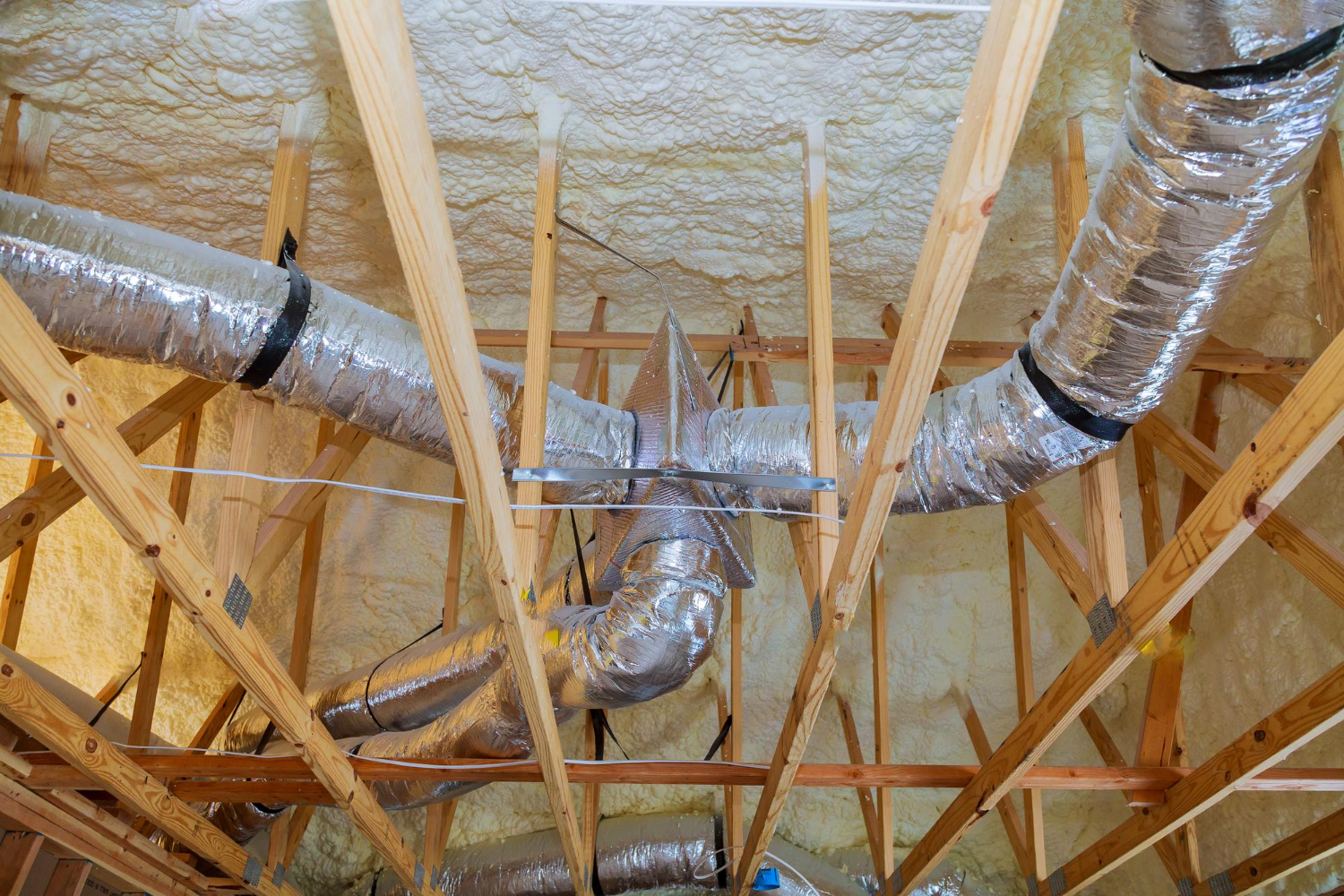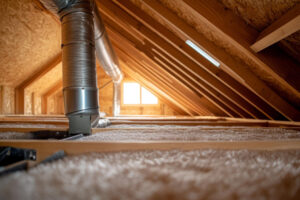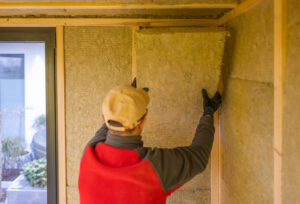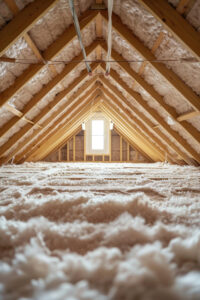Home energy audits can identify cooling inefficiencies, insulation problems, and air leaks that are costing you money right now. During hot weather, temperature differences between your cool home and the warm outdoors make it easier for energy auditors to detect where cool air escapes and hot air infiltrates. This is particularly true for upstairs areas that tend to overheat in summer.
When most people think about energy efficiency, they often focus on winter months when heating bills soar. However, summer presents an ideal opportunity to evaluate your home’s energy performance. The warm weather actually highlights different energy issues that might go unnoticed during cooler seasons.
We recommend scheduling your home energy audit in the morning before the sun heats your home, or in the afternoon when temperature differences are most pronounced.
Taking action based on summer audit findings not only improves your immediate comfort but also prepares your home for efficient cooling now and heating later, potentially saving you money year-round.
In this article, you’ll learn how a summer energy audit helps identify key inefficiencies, reduce cooling costs, and optimize your home’s insulation, ventilation, and energy use.
Keep an eye on the following topics:
- Why summer is the best time for a home energy audit
- What your home energy audit checks (and why it matters)
- Smart upgrades after your home energy audit
- Benefits of a summer energy audit for homeowners
Good reading!
Why summer is ideal for a home energy audit
Summer presents unique opportunities to identify energy issues in your home that might go unnoticed during other seasons. The hot weather highlights cooling system inefficiencies and reveals air leakage problems that directly impact your comfort and utility bills.
Seasonal energy consumption peaks
Summer typically brings the highest energy bills for many households due to constant air conditioning use. These peak consumption periods make it easier to spot inefficiencies. During an energy audit in summer, technicians can measure your cooling system’s performance when it’s working hardest.
We often find that homes use 20–30% more energy during summer months. This increased usage makes it easier to identify where your money is going and which areas need improvement.
An audit during peak season allows us to:
- Evaluate your AC system under full load conditions
- Measure actual cooling costs in real time
- Compare your home’s performance against summer efficiency standards
The contrast between indoor and outdoor temperatures also helps highlight problem areas more clearly than during milder seasons.
Detecting air conditioning and cooling inefficiencies
Summer audits excel at revealing issues with your cooling systems. When temperatures rise, problems with air conditioning units become more noticeable and measurable.
Technicians can check if your AC unit is:
- Properly sized for your home
- Running at optimal efficiency
- Maintaining consistent temperatures throughout the house
- Using the right amount of energy for the cooling provided
We can detect issues like refrigerant leaks, dirty coils, or blocked condensers that may go unnoticed in cooler weather. Thermal imaging cameras work especially well in summer, revealing hot spots in walls, ceilings, and around windows where cool air escapes.
These issues directly impact both your comfort and electric bills during hot months. Finding them early can prevent system failures during the hottest days and support better long-term performance after your home energy audit.
Maximizing energy savings during hot weather
Summer energy audits provide immediate opportunities to reduce cooling costs. The recommendations you receive can be implemented right away for same-season benefits.
Simple fixes identified during summer audits often include:
- Sealing leaky windows and doors where cold air escapes
- Improving attic insulation to keep heat from radiating downward
- Adding window treatments that block solar heat gain
- Optimizing thermostat settings and schedules
We typically find that homeowners can save 10–15% on cooling costs by implementing audit recommendations. Many improvements have year-round benefits too, improving winter efficiency as well. For more insights on effective insulation strategies, check out our article on insulating your house before summer.
Scheduling maintenance for your cooling system based on audit findings ensures it runs efficiently through the remaining hot months. This type of insulation maintenance helps prevent unexpected breakdowns and extends equipment life, saving money in both the short and long term.
What your home energy audit checks (and why it matters)
A comprehensive summer home energy audit examines several critical areas of your home to identify inefficiencies and opportunities for improvement. These assessments help pinpoint exactly where your home is wasting energy during the hottest months.
Evaluating insulation and home envelope
During summer audits, we closely examine your home’s insulation quality in key areas. Attic insulation receives special attention since inadequate coverage allows cool air to escape and hot air to infiltrate. We measure insulation R-values to determine if they meet recommended standards for your climate zone.
Wall insulation assessment involves thermal imaging cameras that reveal hidden gaps where insulation may be missing or compressed. These cameras are particularly effective in summer when temperature differences between interior and exterior walls are pronounced.
Basement and crawlspace insulation evaluation helps identify areas where humidity and heat might be entering from below. Poor foundation insulation can significantly impact your cooling costs.
Home envelope inspection includes examining the roof, siding, and foundation for structural issues that affect energy performance. We look for deteriorated materials that might compromise your home’s ability to maintain cool temperatures. Our insulation services for homes in all climates are designed to address exactly these kinds of vulnerabilities through customized solutions.
Air leaks and sealing solutions
Summer is ideal for detecting air leaks because your air conditioning system creates pressure differences that make leaks more apparent. We conduct blower door tests to depressurize your home and identify where conditioned air escapes.
Window and door frames often develop gaps that allow cool air to escape. We check weather stripping and door sweeps for wear and tear, as these components frequently deteriorate over time and need replacement.
Caulking around fixtures, outlets, and penetrations is thoroughly inspected. Small gaps around pipes, vents, and electrical outlets collectively create significant energy waste that drives up summer cooling costs.
Recessed lighting fixtures and attic hatches are common culprits for air leakage. These areas often lack proper sealing and can act as chimneys that pull cool air up and out of your living space. That’s why a thorough attic inspection is a critical part of any home energy audit performed during the summer months.
HVAC system and ductwork performance
Your cooling system works hardest during summer, making this the perfect time to evaluate its efficiency. We check refrigerant levels, thermostat calibration, and overall system condition to ensure optimal performance.
Ductwork inspection reveals disconnected segments, poor insulation, or leaks that waste up to 30% of cooled air before it reaches your living spaces. We use specialized equipment to measure airflow and identify restrictions.
Filter condition assessment helps determine if airflow is restricted, forcing your system to work harder. Dirty filters can reduce efficiency by 5–15% and shorten equipment lifespan.
Outdoor condenser units receive special attention during summer audits. We check for proper clearance around the unit, clean coils, and verify that fan operation is unobstructed and efficient. If issues are found, timely insulation maintenance can restore airflow efficiency and reduce cooling losses identified during the home energy audit.
Lighting and appliance efficiency
Summer energy audits include a detailed inventory of your lighting fixtures. We identify opportunities to replace inefficient bulbs with LED alternatives that produce less heat and consume less electricity.
Appliance assessment focuses on major energy users like refrigerators and freezers, which work harder during hot weather. We measure their power consumption and compare it to energy-efficient models.
Electronic devices and chargers are evaluated for vampire power draw. These seemingly minor loads can add up, especially when cooling systems are already straining your electrical budget.
Pool pumps and outdoor lighting receive special attention during summer audits. These seasonal energy users often operate inefficiently and present substantial opportunities for savings through timers, variable speed motors, or solar alternatives.
Proper insulation maintenance around these appliances also reduces internal heat buildup. And when cooling demand spikes, having completed an attic inspection as part of your energy-efficient insulation audit ensures your home isn’t working harder than it needs to.
Smart upgrades after your home energy audit
After completing a home energy audit, it’s time to implement changes that will reduce your energy consumption during hot months. These practical strategies focus on managing cooling systems, controlling sunlight, and exploring renewable options.
Thermostat and AC tips to cut cooling costs
Setting your thermostat to 78°F when you’re home can significantly reduce cooling costs. Each degree below this setting increases energy usage by approximately 3–5%. Many smart thermostats allow scheduling to automatically adjust temperatures when you’re away.
Ceiling fans create a wind-chill effect that makes rooms feel cooler without changing the actual temperature. Remember to turn fans off when leaving rooms, as they cool people, not spaces.
Regular maintenance of your cooling system is essential. Change filters monthly during heavy-use seasons and consider upgrading to a heat pump if you have an older AC unit. Heat pumps can be 200–300% more efficient than traditional systems.
Don’t forget to seal ductwork leaks, which can waste up to 30% of your cooling energy. If you’ve already done an attic inspection and reinsulated your attic to increase energy value, these mechanical upgrades will multiply the benefits.
Effective use of blinds, drapes, and sunlight control
Window coverings are powerful tools for summer energy management. Close blinds and drapes on sun-facing windows during peak daylight hours to block heat gain. Light-colored backings on drapes can reflect sunlight back outdoors.
Cellular or honeycomb shades provide excellent insulation, while exterior solutions like awnings can block up to 77% of solar heat. Consider installing solar screens or window films that reject heat while allowing light in.
Strategic window use can also help. Open windows at night when temperatures drop, then close them early morning to trap cool air. This natural ventilation can reduce air conditioning needs in milder climates.
Cross-ventilation (opening windows on opposite sides) maximizes airflow through your home. And if you haven’t already, schedule a summer home energy audit with our experts to identify additional sunlight control opportunities and cooling inefficiencies throughout your property.
Incorporating renewable energy solutions
Solar panels offer a sustainable way to offset summer cooling costs. The longer daylight hours during summer mean increased energy production just when you need it most.
We recommend starting with a professional assessment to determine if your roof gets adequate sunlight. Most systems pay for themselves within 7–10 years through utility savings.
Solar water heaters provide another renewable option, reducing energy use by 50–80% compared to conventional water heaters. For a smaller investment, consider solar-powered attic fans that expel hot air from your upper floor.
Battery storage systems can complement solar installations by storing excess daytime energy for evening use. Some utility companies offer rebates or tax incentives for renewable energy investments, making summer an ideal time to explore these options.
A thorough home energy audit will help you understand whether these renewable solutions are viable for your space and budget, and how they can integrate with existing systems for maximum return.
Benefits of a summer energy audit for homeowners
Getting a home energy audit during summer offers significant advantages for homeowners. An energy audit identifies inefficiencies that affect your comfort and wallet year-round.
Lower energy bills and cost savings
A summer home energy audit can lead to substantial savings on your energy bills. Professional auditors identify areas where cool air escapes during summer and where heat will leak during winter. These leaks force your HVAC system to work harder, using more energy.
By fixing problems identified in the audit, homeowners typically save 5–30% on monthly energy bills. According to the U.S. Department of Energy, sealing leaks and adding insulation can save an average of $200–$400 annually.
Many utility companies offer budget billing options that work well when paired with energy improvements. After implementing audit recommendations, you can often negotiate lower fixed monthly payments.
We’ve seen clients recover their audit investment within months through reduced cooling costs alone.
Enhancing comfort and indoor air quality
Summer home energy audits help eliminate hot and cold spots throughout your home. Auditors use thermal imaging to identify areas with poor insulation or air leaks that create uncomfortable temperature variations.
Proper sealing and ventilation improvements from audit findings can significantly reduce:
- Humidity issues
- Allergens and dust
- Outside pollutants
- Musty odors
With temperatures at their peak, summer audits make it easier to identify comfort issues that might go unnoticed in milder weather. The upstairs rooms that become unbearable in summer are clear indicators of energy efficiency problems.
We find that improved air quality is often the benefit homeowners appreciate most after implementing home energy audit recommendations.
Long-term value and environmental impact
Home energy audits contribute to the long-term value of your property. Homes with documented energy improvements typically command higher resale prices—often 3–5% more than similar inefficient homes.
Making recommended changes reduces your carbon footprint significantly. The average home can reduce its CO₂ emissions by 2,000–4,000 pounds annually after implementing audit findings, according to national energy performance estimates.
Energy-efficient improvements also extend the life of your HVAC equipment by reducing strain on these systems. This means fewer repairs and longer periods between major replacements.
Many audit improvements qualify for tax credits and rebates, further enhancing your return on investment. The federal government and many states offer incentives for energy-saving home improvements identified during professional audits.
Conclusion
Don’t wait for winter to address energy issues, summer is the perfect time to act. A thorough home energy audit reveals the inefficiencies that make your home harder (and more expensive) to cool.
Whether you’re sealing leaks, improving ventilation, booking an attic inspection, or updating your insulation, the steps you take today will improve comfort and savings for seasons to come.
Ready to upgrade your home’s efficiency? Schedule your professional energy audit today and take control of your comfort before the next heatwave hits.





